‘When you fight for the future every day, you need a vision of what that future could look like.’ Interview with Oleksandr Alchiiev, Head of the military administration
Oleksandr Alchiiev, Head of the Beryslav City Military Administration in the Kherson Region, discusses community life under daily shelling, Swedish migrants to Zmiivka village, and why the community needs absolute darkness at night rather than street lighting
By Dmytro Syniak
Even in Soviet times, Beryslav was considered one of the main summer recreation areas on the Dnipro River. There were always lots of people here, which some holidaymakers did not like, so they fled to smaller towns and villages further downstream. Beryslav was located just a few kilometres from the Dnipro HES dam, which created a vast floodplain known as the Kakhovka Sea. In summer, the sea was often busy with large and small ships, motorised and non-motorised boats, and yachts. Now, as a result of Russia’s attack, there are no longer any crowds of holidaymakers or boats here – and the Kakhovka Sea itself has disappeared. Beryslav, like all other towns and villages on the Dnipro, has turned into a ghost town; there is almost no life among the ruins of the half-destroyed houses. As soon as Russian reconnaissance drones detect any movement, they immediately dispatch a deadly ‘bird’ to the area. More than 100 residents of the Beryslav community have already died during the full-scale war. Some of them were simply riding their bicycles to work... Oleksandr Alchiiev, Head of the Beryslav City Military Administration, described the situation to Decentralisation, as well as how the community is surviving, fighting and planning for the future in these extremely difficult conditions.
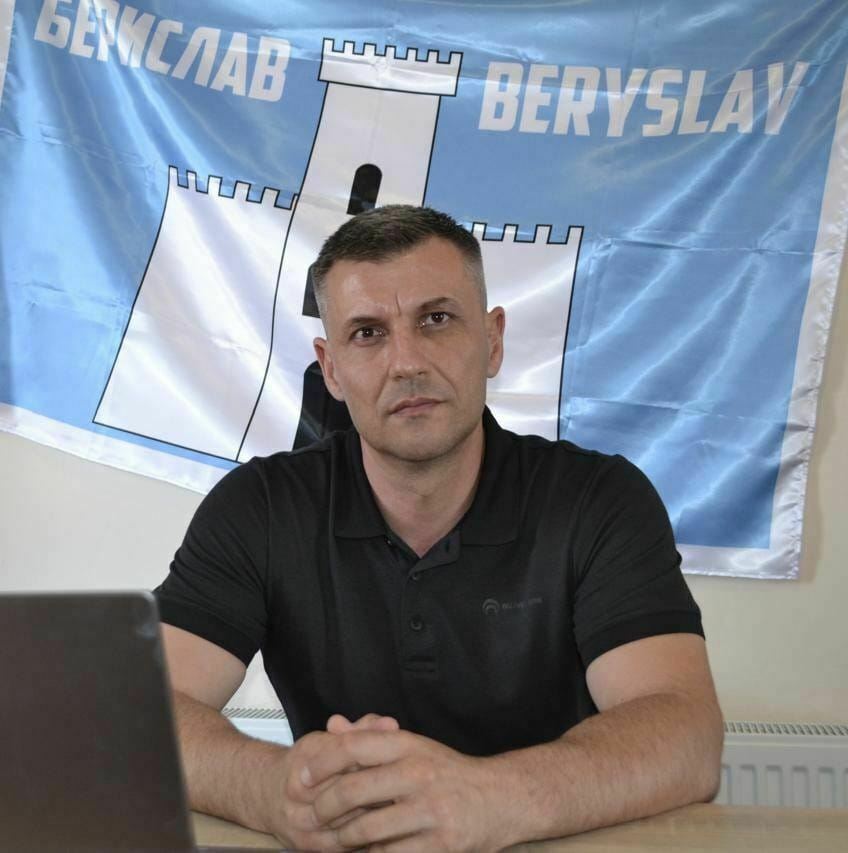
Oleksandr Alchiiev, Head of the Beryslav City Military Administration
1,200 strikes per month
In a few words, how would you describe the situation in your community?
Intense hostilities – that is our situation. The longer it continues, the more difficult it becomes for us. Consider this: we lose an average of one vehicle every month! This means that our vehicles are considered expendable. Sometimes we lose people along with the vehicles. Because of this, we have not been able to deliver humanitarian aid to certain villages for about a month, as the last vehicle carrying out this mission was burned by a Russian drone. Those inside were injured. Our entire operation depends on our people and their experience, endurance and patriotism. It is very difficult to find replacements for those leaving, but the work must go on.
How are you coping with the situation?
Our partners are helping us out. We are currently in the process of obtaining two vehicles from Sweden. To be honest, though, practically no volunteers are willing to be drivers. Even the police no longer want to drive during evacuations. People who waited in their homes until the last minute ‘so that no one would loot what they had accumulated over the years’ began to ask more and more often to be taken to a safe place. In just two weeks, we have evacuated around 30 people. Now, evacuation is no longer just a minibus trip to a specific address. It is a complex, carefully planned operation involving several structures and military vehicles, as well as dozens of people. Each of these people is invaluable. These true heroes risk their lives to help local residents who have finally agreed to leave their homes reach Vinnytsia. For example, we only have one remaining volunteer from Kherson who is willing to transport people. You can imagine how much we value him.
To what extent is your community’s territory controlled by Russian drones?
They control all of the territory. However, the further away from the Dnipro River you go, the weaker this control becomes. To fly more than 20 km, larger and more powerful drones are needed, and the Russians have few of these, so they do not waste them. After all, the farthest point of the Beryslav community is only 15 km from the Dnipro River. The village of Urozhaine, where community life is now concentrated, is about 10 km from the Dnipro riverbank. Nevertheless, Urozhaine has been hit by two drone strikes today alone. We no longer deliver anything to several villages. Those who remain there must fend for themselves. From time to time, however, we still deliver fuel for generators to Beryslav so that the remaining residents can pump water. However, we have not done this for a month now because each new trip is more dangerous than the last. There is no question of delivering food. However, people have stocked up on food for a considerable amount of time, so there is no risk of hunger for the foreseeable future.
On 10 November, a Russian FPV drone struck a minibus travelling between Kryvyi Rih and Novovorontsovka. The attack killed a 50-year-old man from Nikopol and injured two others: a 19-year-old woman and a 44-year-old man. Is there any public transport still operating in your community?
Compared to us, Novovorontsovka is much safer. They have water and electricity, and only a few attacks occur there per week. Here, we have 40–50 attacks per day and 1,200 per month. They use artillery, tanks and mortars – anything they can find. In Novovorontsovka, minibuses still run, for example. But here, in spring 2025, the last social taxi driver refused to take the route. I understand why: life is more important! And forget about taxis – just yesterday, a Russian drone attacked our doctor's car. He was travelling from Urozhaine to Tarasa Shevchenka village. Fortunately, the drone missed, and the people in the car escaped with only minor injuries. But while a car can dodge a blow, an electrical transformer cannot. Nor can a medical clinic. Nor can a water tower. Consequently, the community's infrastructure has been almost completely destroyed.
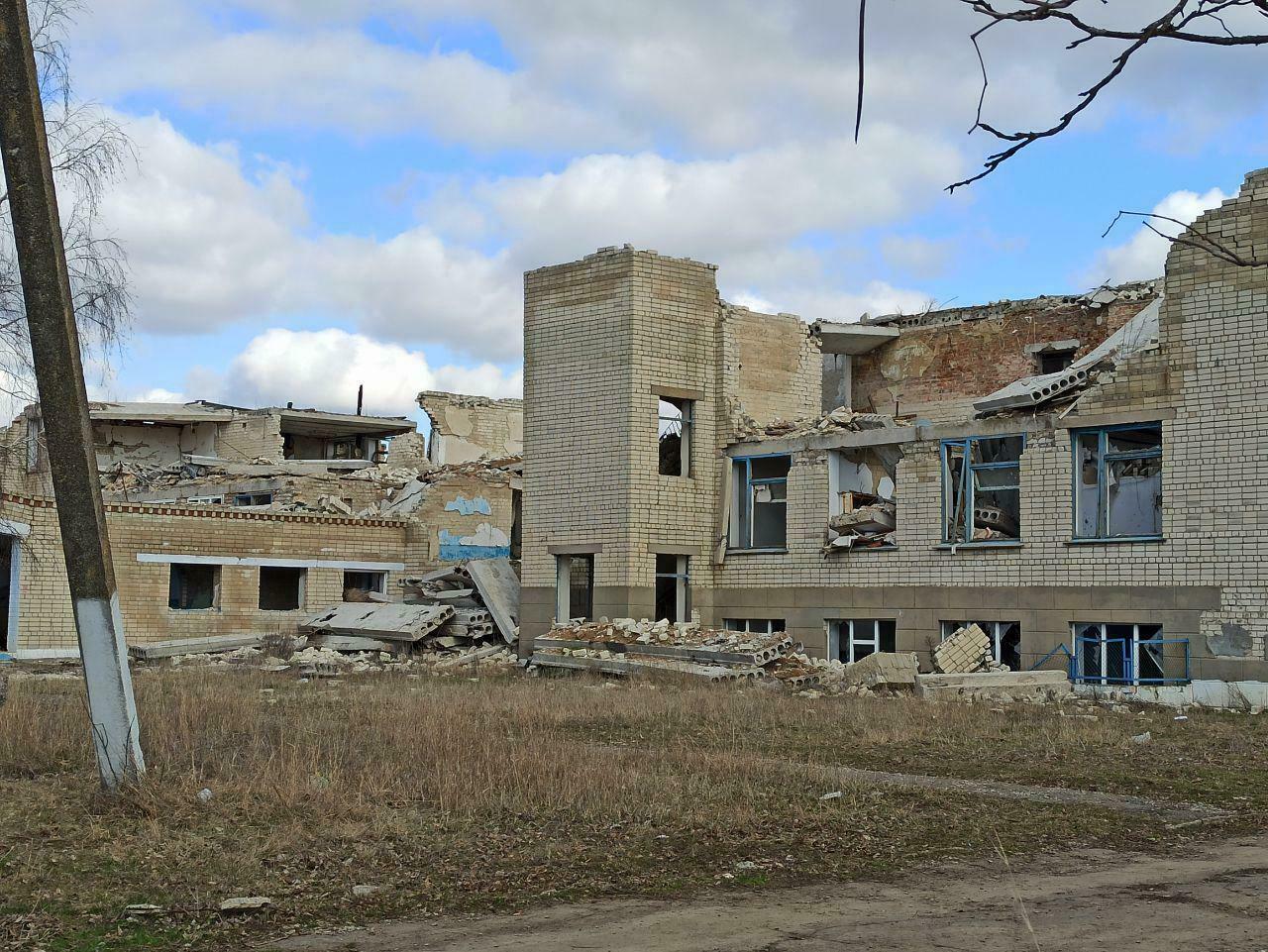 School building No. 2 in Urozhaine village
School building No. 2 in Urozhaine village
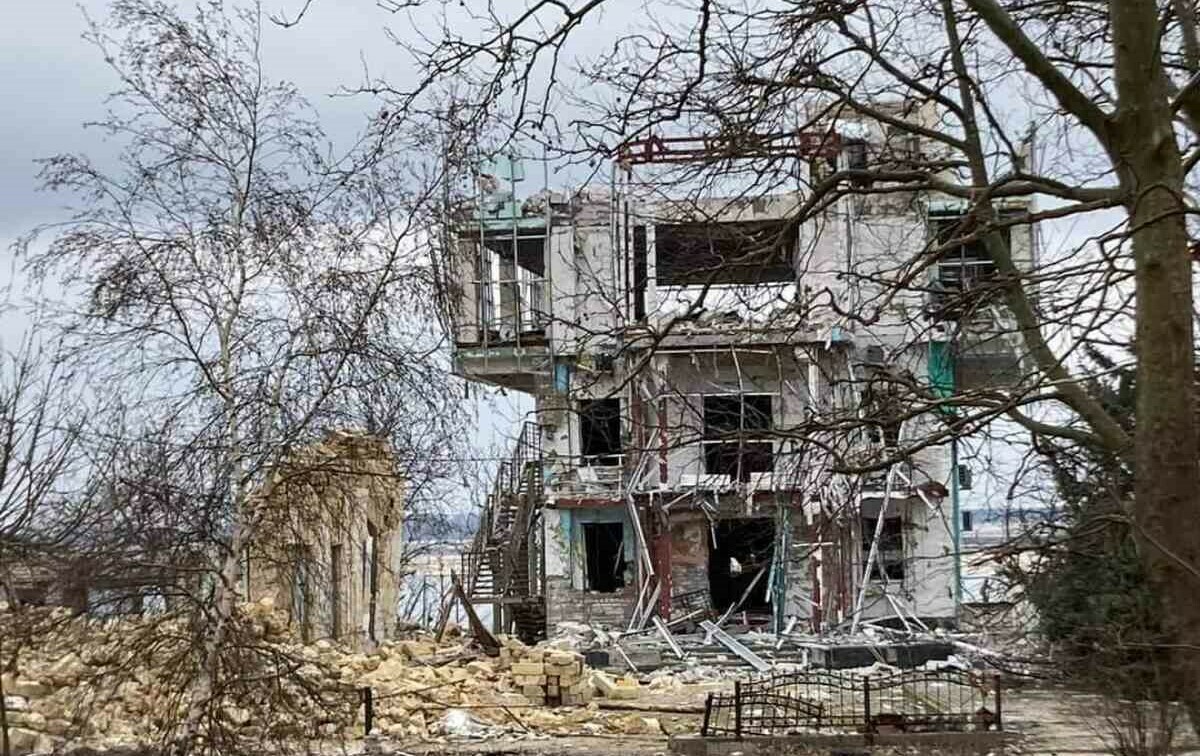
This building was used for many years by the Beryslav District Employment Centre

The remains of the department store in the centre of Beryslav
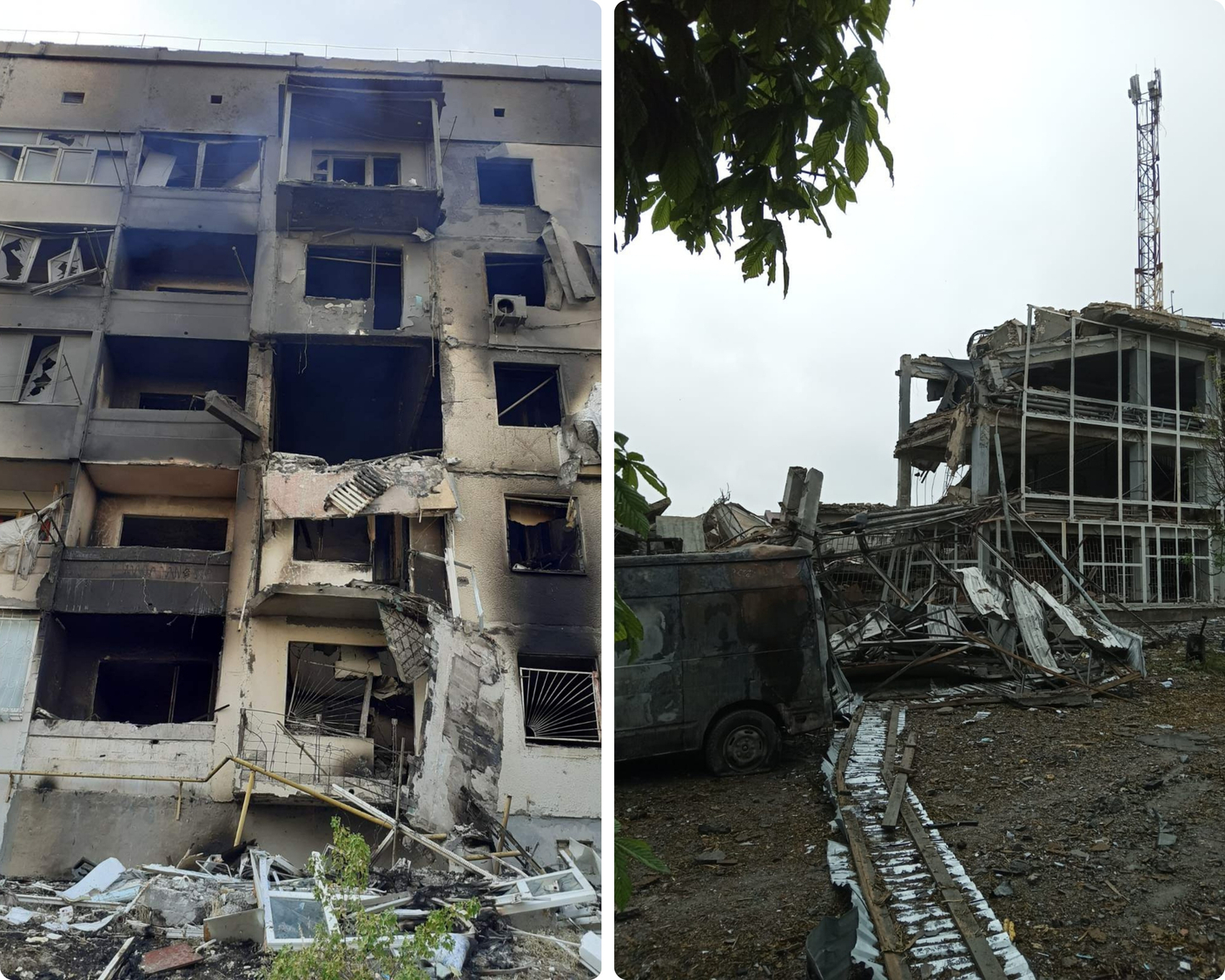 Although these buildings appear completely destroyed from the outside, it is impossible to assess their structural integrity without a thorough inspection. This means that their residents cannot receive compensation
Although these buildings appear completely destroyed from the outside, it is impossible to assess their structural integrity without a thorough inspection. This means that their residents cannot receive compensation
The centre of Beryslav now looks like this
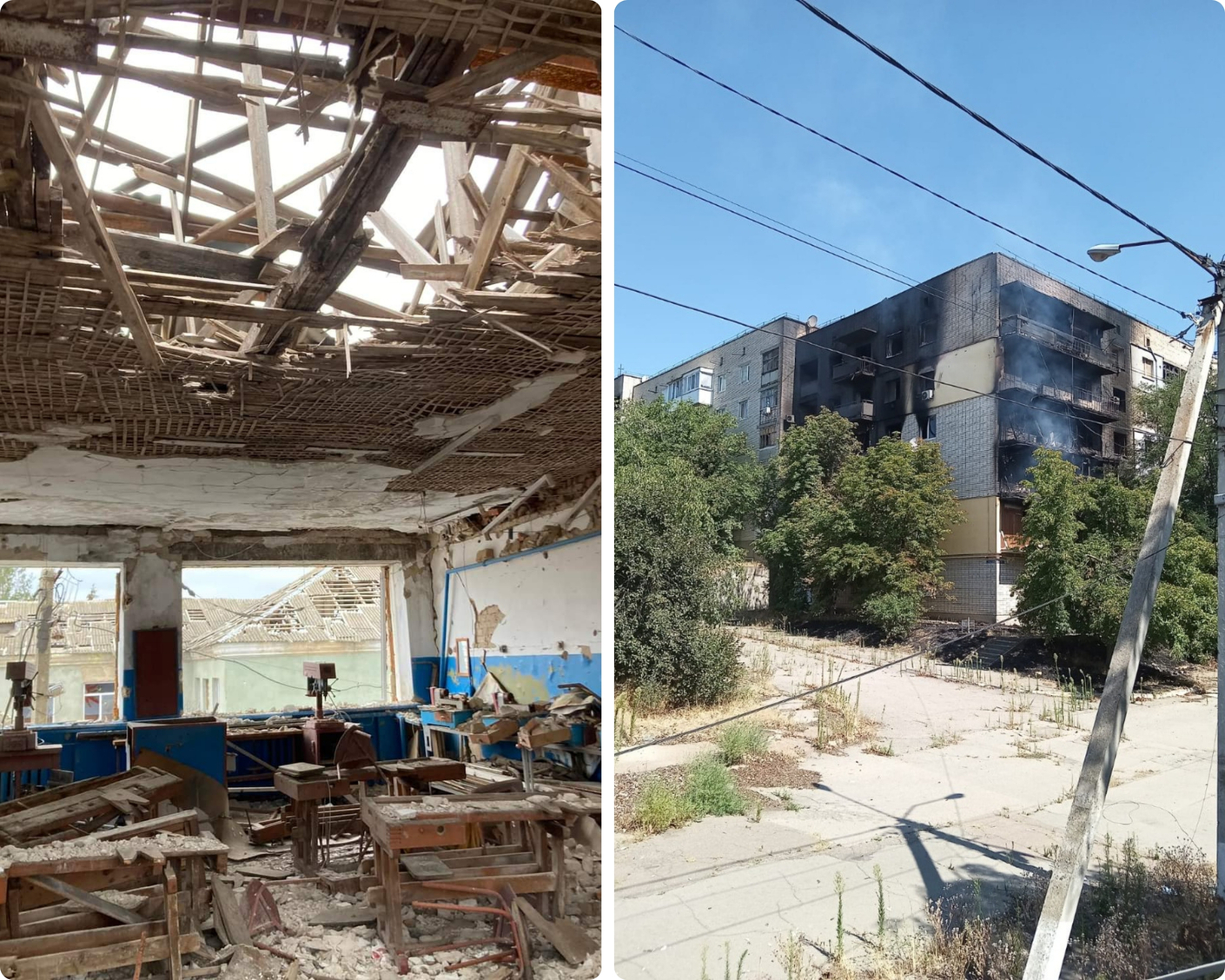
The workshop of Beryslav Lyceum No. 3, where vocational classes were previously held, now looks like this (right photo)
A residential building in the centre of Beryslav, with an archive and the offices of the Civil Registry on the first floor (left photo)
‘The Russians want to destroy life in the coastal strip as such...’
How do people live in these conditions? Are many community members literally left in the line of fire?
Around 440 people remain in Beryslav, compared to approximately 12,000 prior to the full-scale war. In total, approximately 1,000 people remain in the community, compared to around 18,000 prior to the Russian invasion. Only a few people live in the coastal villages – between seven and 20. However, communication is mostly non-existent there, which makes it very difficult to take an accurate census. Needless to say, there is no water supply, electricity, gas or heating. Instead, the danger from Russian drones and artillery remains very high. Nevertheless, people still ‘guard their homes’ and refuse to listen to any persuasion from the local authorities. They only decide to leave when their house has been completely destroyed, along with all their possessions. Now, however, it is very difficult to leave. The problem is not just the Russian drones; the enemy also drops anti-personnel mines, or ‘petals’, from drones. Some of these mines are so powerful that they can pierce a car’s armour. The last time we drove to Beryslav, our car hit one of these mines and was torn in two. Fortunately, none of the people in the car were injured.
On the other hand, you are protected by the Dnipro River, so a breakthrough across it is unlikely. Would you say this puts you in a slightly better position than other communities on the front line?
I would argue that the Dnipro River is not particularly significant, given that Russian drones can easily fly 20–25 kilometres. Therefore, there are no safe places in our community. The Russians have complete control over Beryslav, which is located on the riverbank, both during the day and at night. Previously, we could still do some work at night, but we can no longer do so as the enemy has night vision devices...
What does Beryslav look like now?
The city has been almost completely destroyed. There are no undamaged buildings; only ruins remain. A year ago, we were planning to restore what remained, but now, to be honest, there is nothing left to restore; we have to rebuild everything from scratch. Last winter, for example, 14 guided bombs hit our district hospital alone! Fourteen! After that, we relocated our staff and property to the neighbouring Borozenske community. Almost all of our equipment survived because the medical staff had been working exclusively in the basement for a long time. It withstood the attack. It is a very good, high-quality basement. However, it was clear that a few more guided bombs would destroy it completely.
Does it make any military sense to strike infrastructure and empty residential buildings?
I have no idea. It seems to me that the Russians just want to destroy life in the coastal strip as such. They will stop at nothing. As soon as they spot any movement inside a house, they demolish it. There have been many cases where drones have been used to attack people riding their bicycles to work. Of course, they could see that these were civilians because their drones usually have good optics. Yet they killed and maimed them anyway. Among our residents, there are dozens of people with amputated limbs. This is not only as a result of such strikes; some were blown up by the ‘petal’ mines I mentioned. The military is constantly clearing the community’s territory of Russian mines, but the enemy mines it again. Each time, they use more powerful and dangerous mines with a larger radius of destruction. This has been going on for three years now.
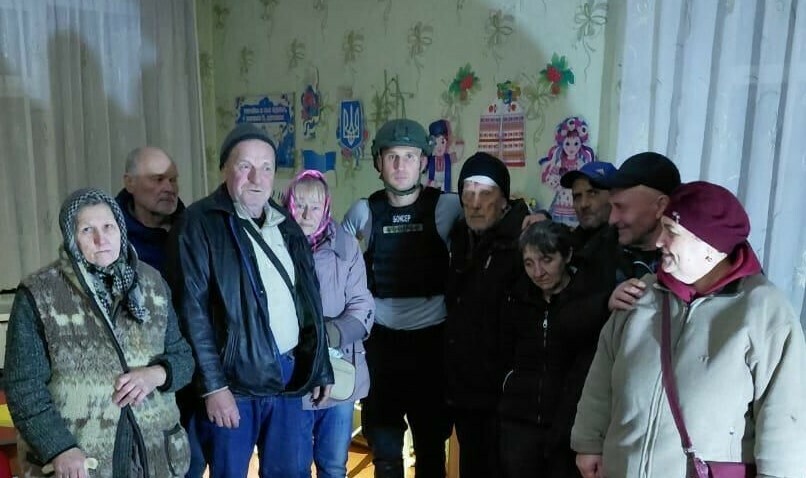
Nine residents of the Beryslav community were recently evacuated from dangerous areas at great risk to their lives by Andrii Pietukhov (centre), a volunteer, and the Beryslav City Council team, with the support of deminers from the 153rd Separate Mechanised Brigade of the Armed Forces of Ukraine who cleared the road of mines
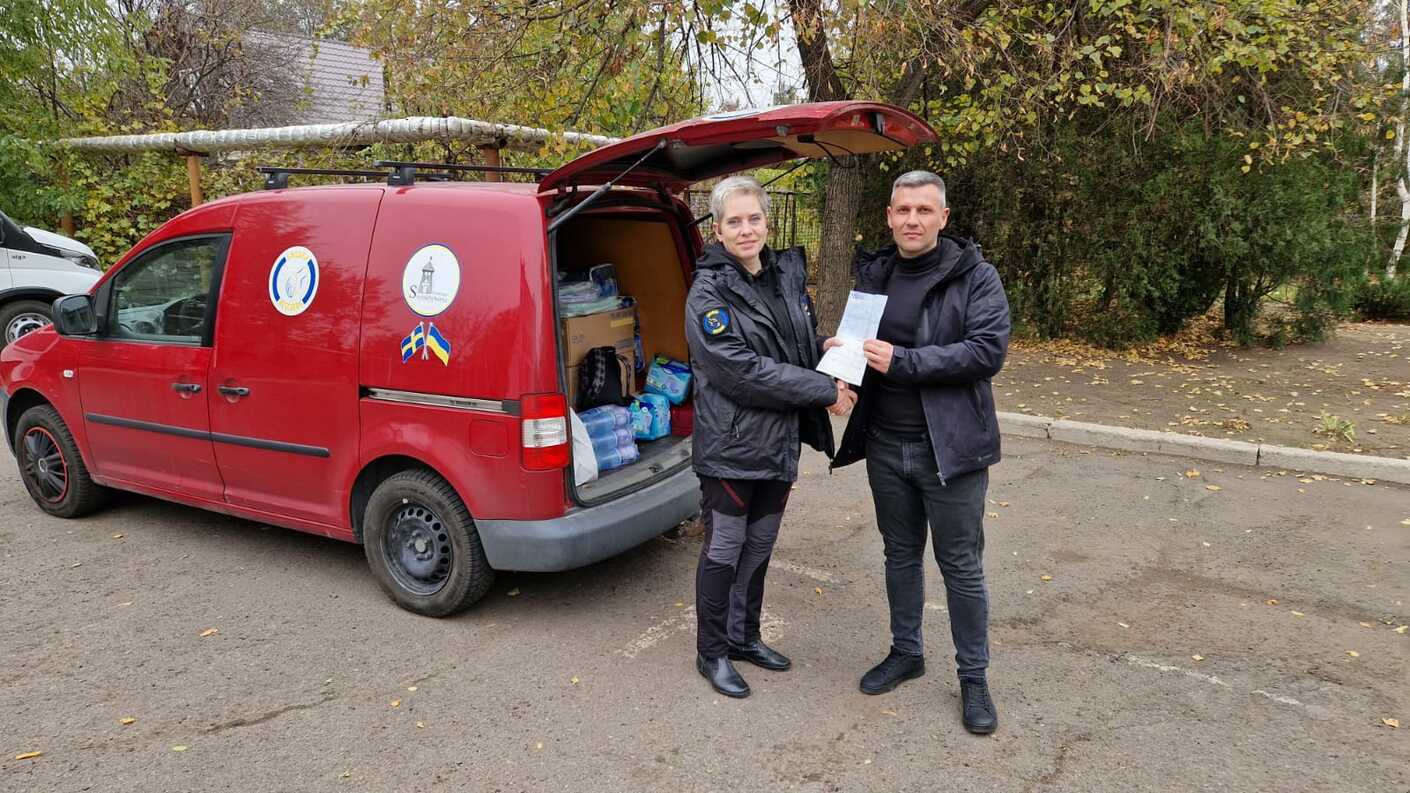 Swedish friends of the Bereslav community – the NGOs Swedish Rescuers and Svenskbyborna – handing over a vehicle for humanitarian needs of the military administration...
Swedish friends of the Bereslav community – the NGOs Swedish Rescuers and Svenskbyborna – handing over a vehicle for humanitarian needs of the military administration...
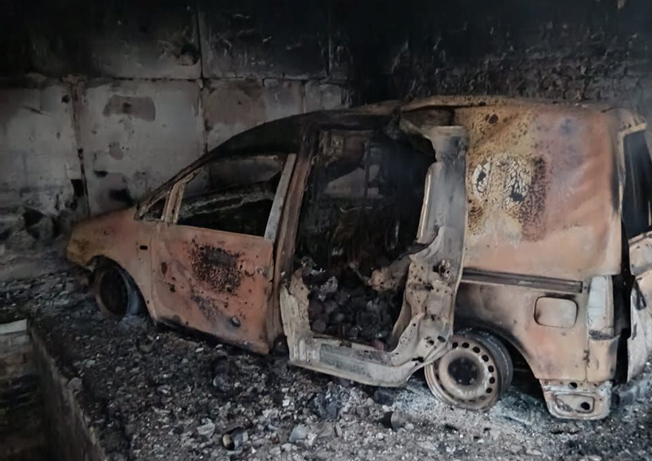
… and the Russian ‘brotherly people’ burn it down. An invader drone attacked the car at the entrance to Beryslav this summer. It was carrying food parcels from World Central Kitchen and diesel fuel for artesian well generators. Everything burned down. Fortunately, the driver and passengers survived
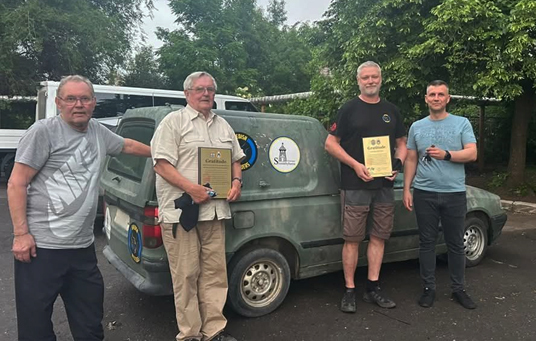
Ceremonial handover of a vehicle for humanitarian needs to the Beryslav community from Swedish NGOs – Swedish Rescuers and Svenskbyborna …

… and what the Russian drone left of the car
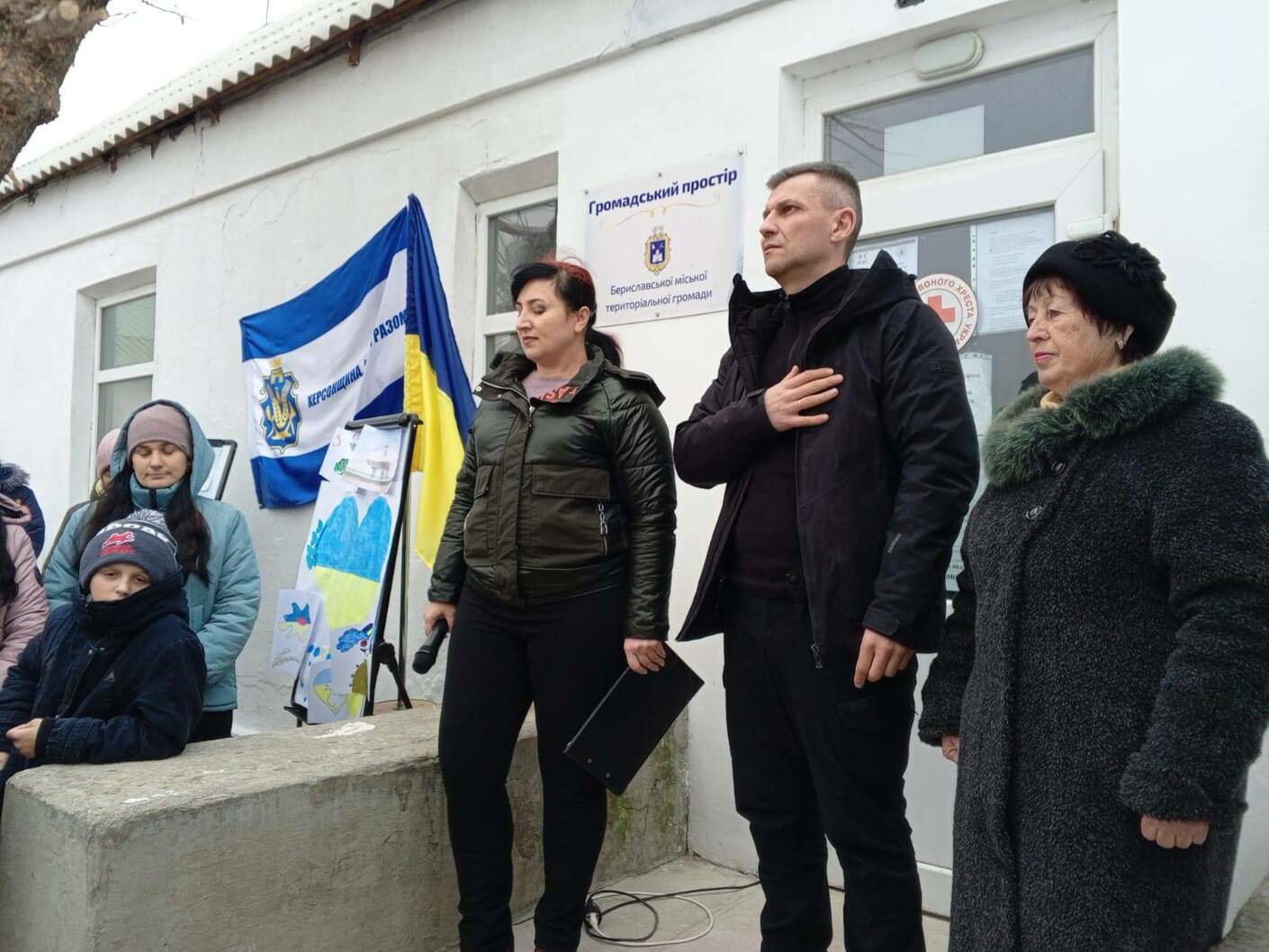
Celebration in the public space in Velyka Oleksandrivka village to mark 11 November – Liberation Day of the Beryslav community, 2024

Weekly bread delivery to villages in the Beryslav community, initiated by the ADRA Ukraine Charitable Foundation
About the online kindergarten and participation in the ‘Shoulder-to-Shoulder’ project
How are the city council, social services, and starostas managing to work in such terrible conditions?
They are working as usual, but have relocated to villages further away from the Dnipro. Some of our departments have been transferred to other communities. For instance, our social services department is now based in Velyka Oleksandrivka. When security allows, employees from this department travel around our villages distributing humanitarian aid. Our utility workers also continue to work. This year alone, they have replaced around 8 km of water pipes and installed a solar substation to power water pumps. The Red Cross has promised to provide us with three more substations. The utility workers have also assembled and connected the modular houses provided to us by the Rivne City Council, our partner in the ‘Shoulder-to-Shoulder’ project, to utilities. These houses are very good, with insulation, toilets, shower rooms and a shared kitchen. With their help, we are also building bomb shelters and creating public spaces. This is so that people have a place to relax and socialise.
Please describe in more detail the participation of the Beryslav community in the ‘Shoulder-to-Shoulder: Cohesive Communities’ project. What is your attitude towards the project?
It is a very good and timely project. It is important that relatively safe communities understand how communities on the front line, such as ours, live. They should not only be aware of this, but also support us in every way possible. In addition, the ‘Shoulder-to-Shoulder’ project is helping to make Ukraine more united and cohesive. It has also become easier for us to seek support from international partners as our partner communities have started sharing their connections with us.
What partners does the Beryslav community have within the framework of the ‘Shoulder-to-Shoulder’ project? In what ways have they helped you?
We have several partners, including the communities of Novovolynsk, Rivne, Kolomyia, Dolyna, and Voznesensk. We are currently seeking to sign a memorandum of partnership with the Adzhamka Settlement Council in the Kirovohrad region. They have been assisting us for a long time. Many people from our Tomaryne village live there and receive significant support from the local authorities. We have excellent relations with them and wish to strengthen them by participating together in the ‘Shoulder-to-Shoulder’ project. As I mentioned, the Rivne City Council provided us with free modular houses. We installed these in Urozhaine and set up invincibility points in several of them on the road to Tarasa Shevchenka village. In addition, our children have travelled to various competitions and cultural events in partner communities. This is very important for them.
You mentioned that you transferred the Beryslav District Hospital to the Borozenske community. What about your outpatient clinics and paramedic stations?
We recently opened a modular paramedic station in Urozhaine and, before that, a mobile station in Tarasa Shevchenka village. We are now working on opening a modular paramedic station in Rakivka, as the original premises were significantly damaged by a Russian guided bomb. We have not forgotten about our hospital in Borozenske, either. We now intend to establish a rehabilitation centre there. We have already applied for a grant for this project.
Have you managed to keep the community schools open?
Yes, we currently have two lyceums operating online, with around a thousand children enrolled. Several other schools have had to suspend their work. Another interesting fact is that we have an online kindergarten preparing around 20 children for school.

Beryslav utility workers working part-time for the local fire department are repairing the roof of a private house damaged by Russian shelling
 Distribution of humanitarian aid to residents of the Beryslav community in Velyka Oleksandrivka village
Distribution of humanitarian aid to residents of the Beryslav community in Velyka Oleksandrivka village
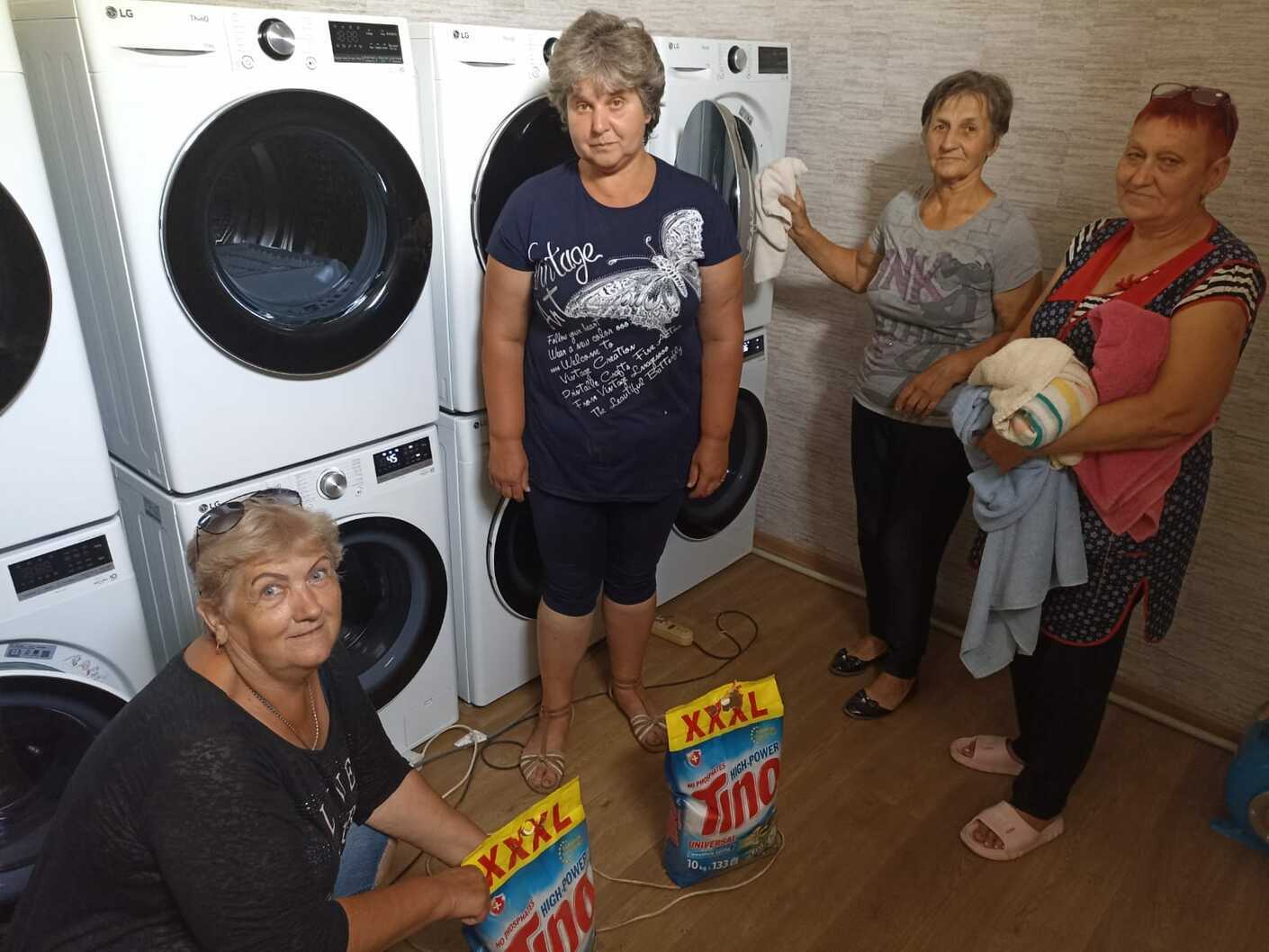
A mobile laundry in Beryslav, funded by the Renaissance Charitable Foundation. A few months ago, it was destroyed by Russian drones. The same happened to the mobile laundry in Tomaryne village. The last one remains in Urozhaine
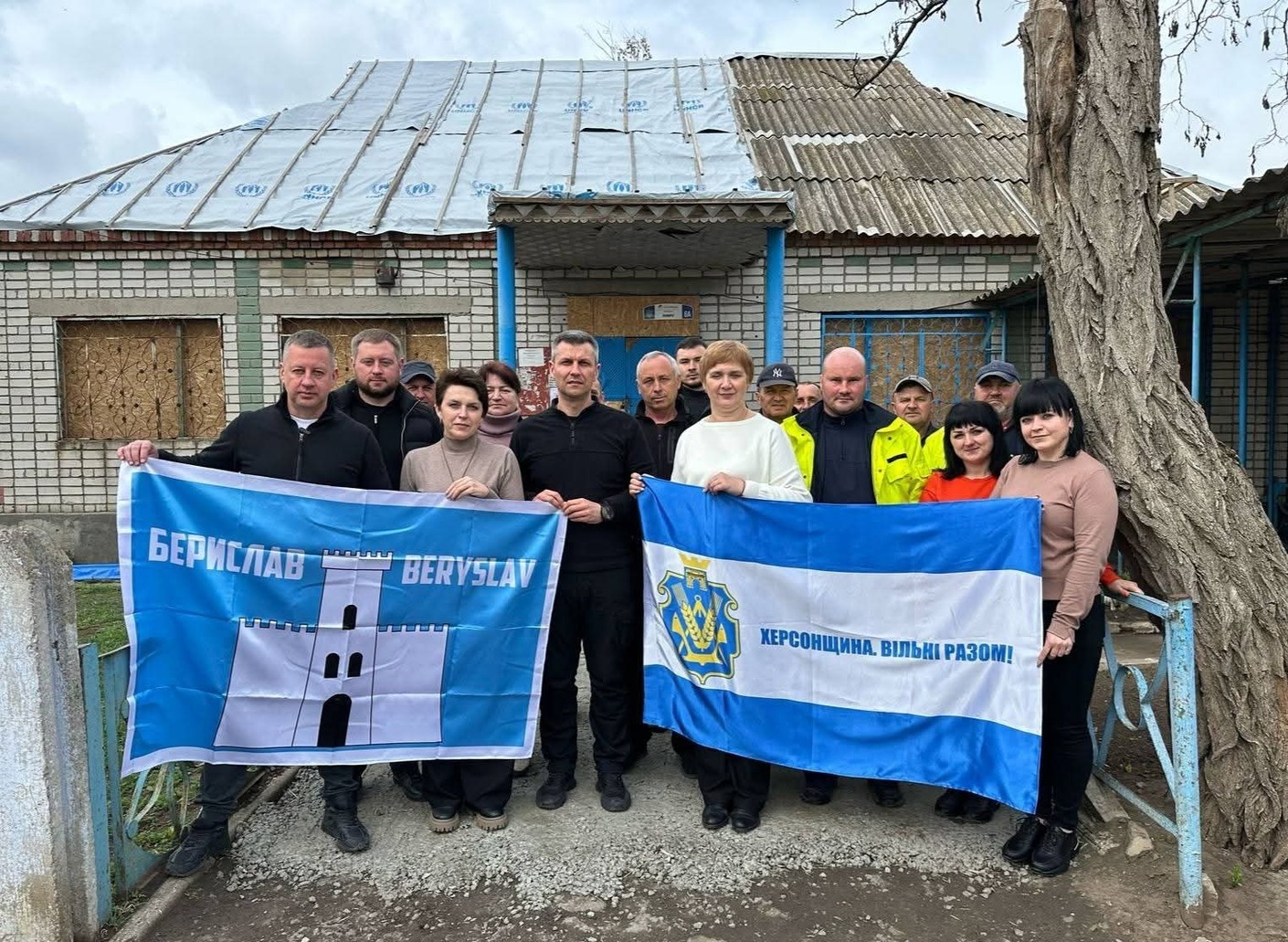
A year before signing the memorandum of partnership for the ‘Shoulder-to-Shoulder: Cohesive Communities’ project, a team from the Rivne City Council visited Beryslav. On the far left is Viktor Shakyrzian, Secretary of the Rivne City Council, and in the centre is Oleksandr Alchiiev, Head of the Beryslav Military Administration. 31 March 2024
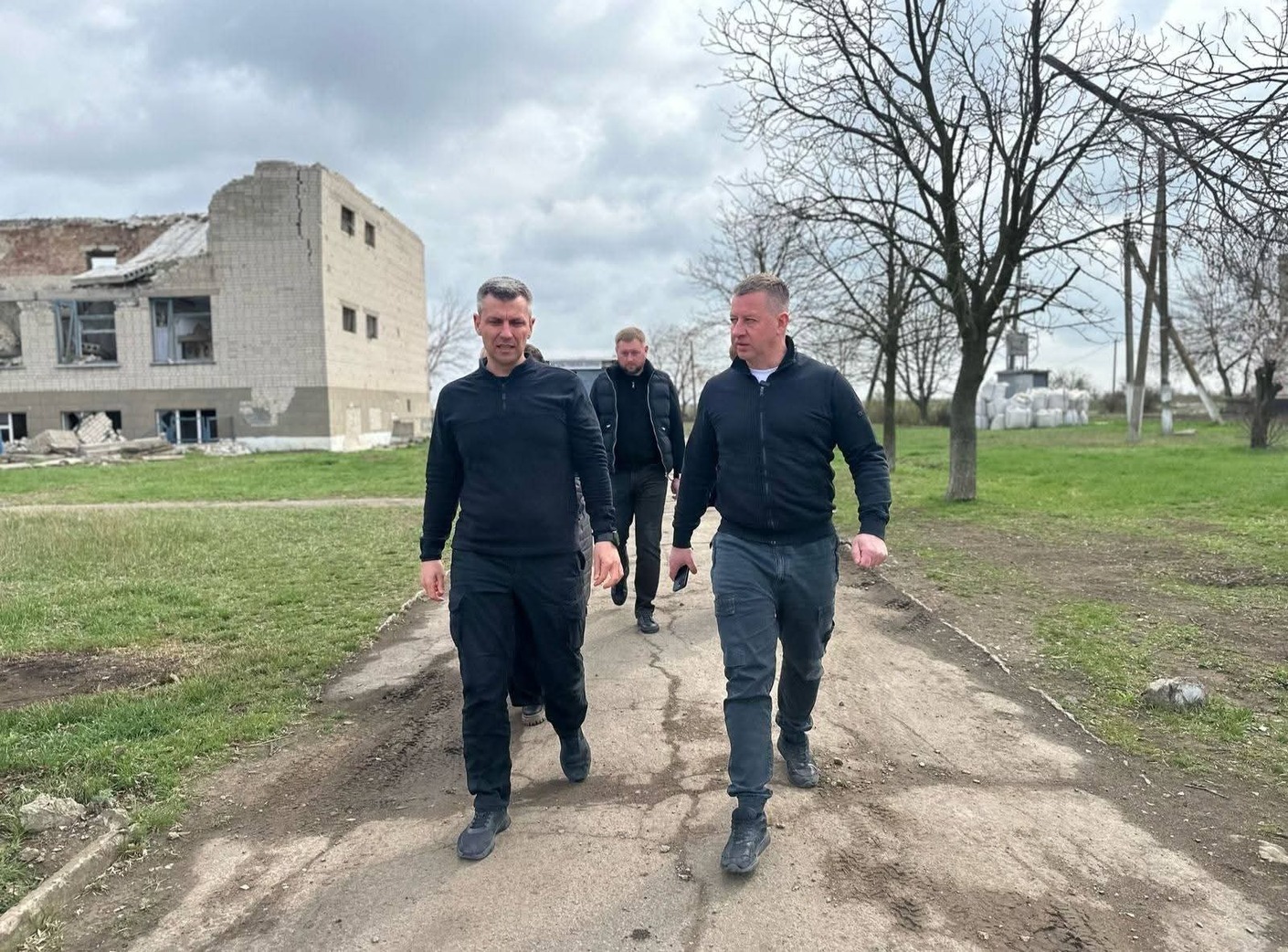
Viktor Shakyrzian, Secretary of the Rivne City Council (right), and Oleksandr Alchiiev, Head of the Beryslav Military Administration, in Beryslav. 2024
‘Russian drone kills the head of the Farmers’ Association…’
You said that the community was home to more than 18,000 people before the full-scale war broke out. Where are they now? Do you have any idea?
Most of them live in neighbouring communities and in Kryvyi Rih. This is why we have set up three hubs in Kryvyi Rih, Novoraisk, and Velyka Oleksandrivka. Only humanitarian aid is distributed in Novoraisk, while the Velyka Oleksandrivka hub offers various clubs for children and is home to our Administrative Services Centre and social protection department. A third-age university has also been established in Velyka Oleksandrivka and Kryvyi Rih, where elderly displaced persons take part in Nordic walking and make camouflage nets for the military. Our education, finance and accounting departments operate in Kryvyi Rih. There is also a small public space where we hold various events.
What are the biggest problems faced by displaced persons?
Housing and the money to rent it. This is a huge problem, so I think assistance for IDPs needs to be increased. Perhaps it should be targeted, for example towards housing rentals, but it needs to increase. Incidentally, I am very pleased that, in July 2025, the Cabinet of Ministers permitted the use of remote surveys to assess the damage to property. The military are helping us a lot with these surveys, as they have high-quality drones and know how to use them skilfully. Thanks to them, around 30 people have already received financial compensation for their destroyed property. We are currently processing around 50 more videos. This is not a large number, but many people do not have the necessary documentation for their property, which prevents us from processing more applications. Additionally, Beryslav had many apartment buildings, but unfortunately, we are not permitted to survey these buildings, even remotely. This is because it is usually impossible to determine whether a multi-storey building needs to be repaired from a drone. As far as I know, the Government is currently discussing this issue.
The Kherson region has very fertile soil, but nothing will grow unless it is watered. What is the situation with the region’s irrigation systems? Are they functioning? How is business in general in the Beryslav community?
Businesses, particularly farmers, are finding it very difficult. Oleksandr Hordiienko, the head of the Kherson Region Farmers’ Association, was killed this year. He was attacked by a Russian drone in the field while he was working. Such cases are not rare. Tractor drivers are frequently targeted by Russian drone operators. In addition to the threat posed by drones, this year has also seen an abnormal drought, resulting in very modest harvests. This is because all irrigation systems have long been out of order. Therefore, for the second year in a row, we are not charging any rent for land. Those who are working are true heroes, and we are trying to support them in every way possible.
What you and other residents of the community are doing is truly amazing. Tell us: what shocked you the most during the full-scale invasion? What has stayed in your memory?
Last winter, a Russian drone hit a rubbish truck that was just collecting waste. The utility company director was driving because nobody else wanted to; everyone was afraid. A young man travelling with the director suffered fatal injuries in the attack. He died in the director’s arms. I witnessed the entire incident and will never be able to forget it. After that incident, we stopped collecting rubbish.
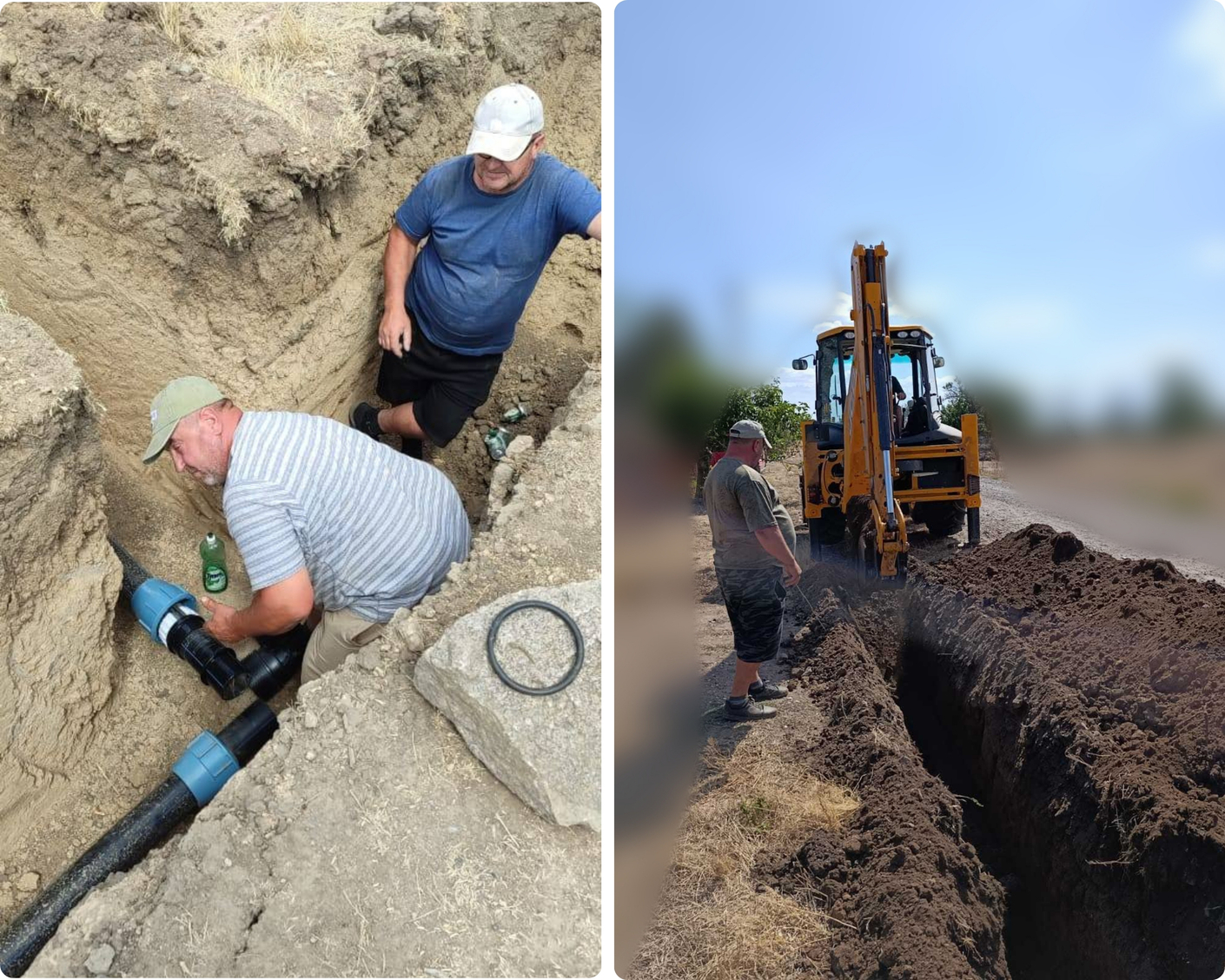
Repair of the local water supply system by the fire brigade
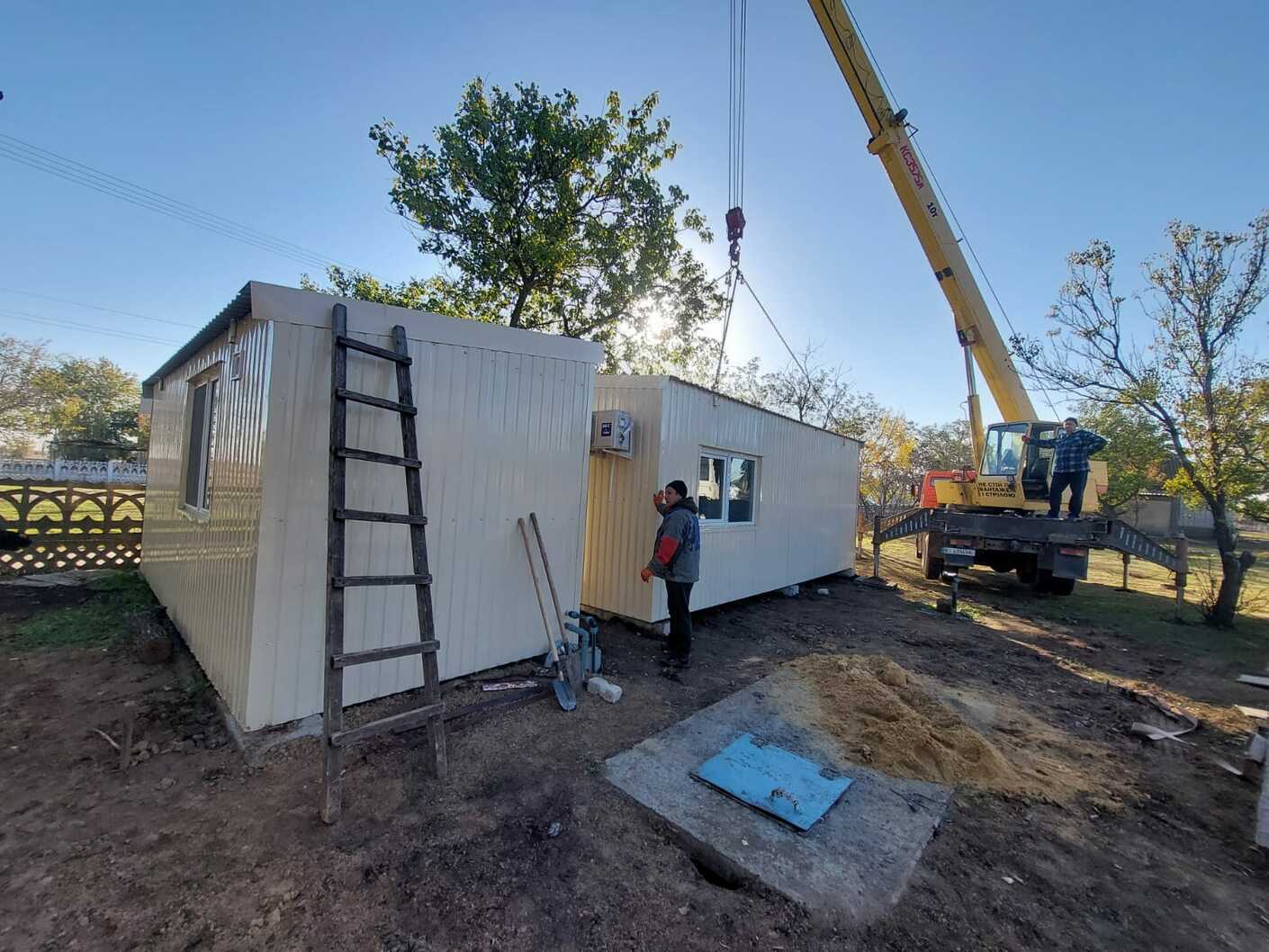 Modular primary health care facility in Urozhaine village
Modular primary health care facility in Urozhaine village

Public space of the Beryslav community in Velyka Oleksandrivka village

Фото 23. The solar power plant of the Beryslav community and its new fence, installed at the expense of the charity funds ‘Sky of Ukraine’ and ‘Renaissance’. The installation was carried out by employees of the Zmiiv utility branch of the local fire department
Why do Swedes consider the Beryslav community their home
Please share your thoughts on international cooperation. How do you find partners? What does cooperating with them entail?
Firstly, we are fortunate to have a so-called Old Swedish village called Zmiivka. Back in the days of Catherine II, Swedes from the island of Dagö (now part of Estonia) were resettled there. The Russians captured the island and sent all its inhabitants to Zmiivka. After 150 years, their descendants returned to Sweden, primarily settling on the island of Gotland. Now, the grandchildren and great-grandchildren of those people support Zmiivka. Moreover, our friendship and cooperation have only deepened in the context of full-scale war. In particular, we received fire engines from Gotland, which we used to set up a local fire brigade in Zmiivka. We also received several passenger cars for our military, police and military administration. Residents of Zmiivka regularly receive medicine, fuel briquettes and other items needed in such difficult circumstances from our partners in Sweden.
= = = = = = = = = = = = = =
ВРІЗКА:
How the Russian empress sent the Swedes to the Kherson region and brutally deceived them
Zmiivka village was founded by Swedes who were expelled from the Baltic island of Dagö (now Hiiumaa in Estonia) by Russian Empress Catherine II, after which they settled in the Kherson region. When the island was transferred to Russia under the Treaty of Nystad in 1781, more than 1,200 indigenous inhabitants were evicted from their homes in return for houses and land in the Kherson steppes. However, of those who set out on the 2,000 km journey, only half managed to reach their destination. When they arrived on 1 May 1782, the Swedes realised that the Empress had deceived them – there was nothing but endless steppe around them. With no other option, the settlers established a settlement called Altswedendorf, meaning ‘Old Sweden’. By March 1783, only 135 remained. A few years later, they were joined by several dozen Swedish prisoners of war captured by Russia. Then, in 1804, German colonists from Württemberg arrived and renamed the village Schlangen Dorf, meaning ‘Snake Village’. However, the Swedes were Lutherans and the Germans were Protestants, so the two groups hardly assimilated. When a Swedish Lutheran church, or kyrka, was opened in Zmiivka in 1885 using funds raised in Sweden and Finland, the village’s population was over 500. Almost all of them left for Sweden, mainly to the island of Gotland, in 1929.
Фото 24. Swedish Lutheran church in Zmiivka village, burned down by Russian drones and shells. Photo taken before the full-scale invasion
Фото 24а. Residents of Zmiivka unfurling the Swedish flag presented to them by King Carl XVI Gustaf of Sweden, who visited Ukraine in 2008. This flag is an important local relic. During the Russian occupation, it was saved from the invaders by Mykola Kuryvchak, the starosta of Zmiivka, by hook or by crook. One day, a Russian shell hit the house where the flag was hidden. However, the flag survived, albeit damaged. It is now in a safe place outside the community. On 12 September 2025, Svitlana Zalishchuk, Ukraine’s Ambassador to Sweden, posted photos from this photo shoot on her Facebook page, noting that Carl Gustaf was extremely moved when she told him about the fate of his gift
== = = = = = = == == = = = = = =
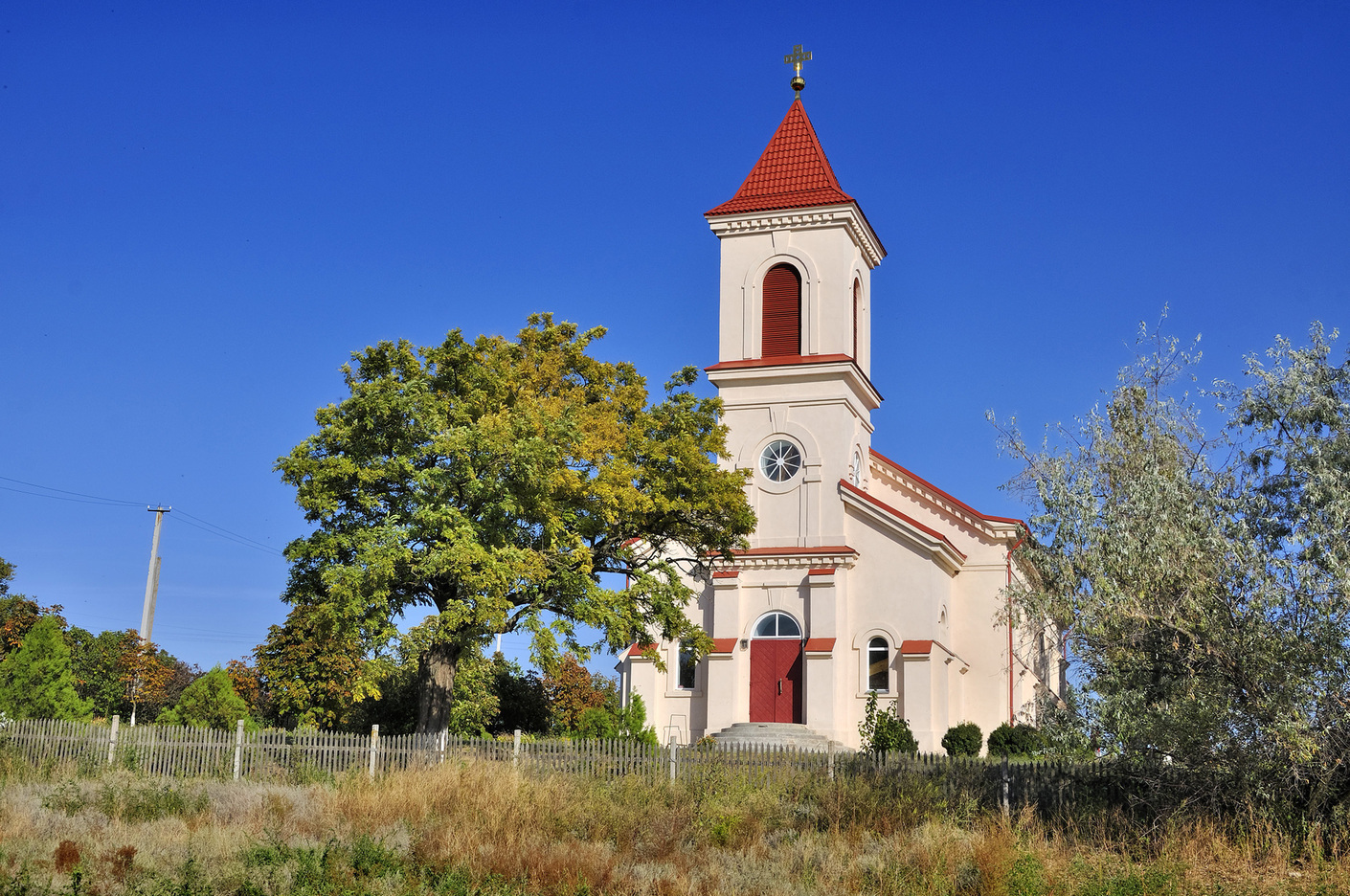
Oleksandr Alchiiev, Head of the Beryslav Military Administration, handing over charging devices to the unit that defends the community. This became possible with the financial support of the community's Swedish partners: the public associations Svenskbyborna, Swedish Rescuers, and Power Up Ukraine
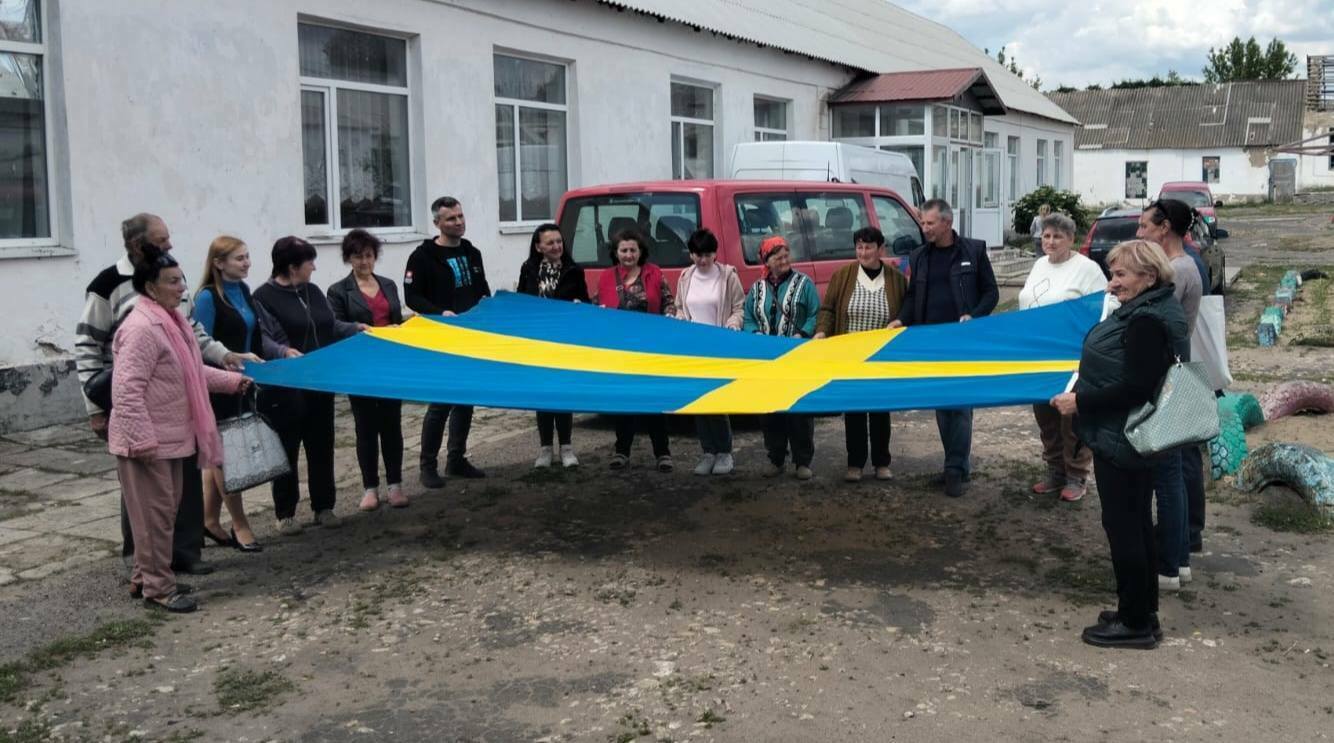
The financial support of Swedish friends of the Beryslav community – the Swedish Rescuers and Svenskbyborna public associations – helped set up the Zmiiv branch of the local fire service, which is temporarily based in Urozhaine village for safety reasons
Is the municipality of Gotland your only foreign partner?
We receive a great deal of support from various charitable organisations abroad, as well as from Ukrainians who have relocated to other countries due to the war. For instance, we recently entered into a partnership with the Dutch municipality of Winterswijk. I also signed a memorandum with the German municipality of Eutin this summer, immediately receiving 100 solar-powered lanterns under the German government programme GIZ. Unfortunately, we cannot install them yet due to the large number of Russian drones in the area. Furthermore, we currently require absolute darkness at night rather than light, so we are implementing numerous light-masking measures. Our German partners also provided us with a truck with a lift, and we are currently negotiating with them for a vehicle for people with reduced mobility. Another project we are working on involves creating a position for an investment and international partnership specialist. Their salary will be paid from the project funds.
Did you have no such specialist before? How did you seek international assistance then?
Each department sought assistance to the best of its ability and within its means. The departments of education and the economy were primarily responsible for this area. However, it would be very good to have a full-time specialist who was not paid for out of our own funds. After all, we are currently trying to allocate every spare hryvnia to supporting the Armed Forces of Ukraine and programmes for veterans and families of the fallen. It is also important to us that this project can fund visits to partner communities. This is because we want to organise a trilateral partnership, not a bilateral one: Eutin, Gotland, and ourselves. This will provide many more opportunities to raise funds. Another international project we are involved in is Ukrainian-Polish. As part of this project, our children recently travelled to Węgorzewo County in Poland, with which we have signed a memorandum of cooperation and a twinning agreement between educational institutions.
In what ways could the Government and Parliament assist you? Which legislative initiatives do you think should be implemented?
I would very much welcome the simplification of the compensation process for property that has been destroyed. Numerous photos and videos in the public domain show that some localities have been completely destroyed. It is unreasonable not to pay compensation to people simply because the relevant commission is unable to access the area.
Have you thought about the future of the community? If so, what is your vision for it?
We think about the future, and we receive a lot of hate from local residents for doing so. They say that we may not even be able to keep the community together, and that the Muscovites may turn it into a mine-covered desert. Meanwhile, you are thinking about where to build a school and set up medical stations. Yes, we understand how difficult it can be to implement all our initiatives, but, in my opinion, this is not the main issue. When you fight for the future every day, you need a vision of what that future could look like. This provides motivation. Without a vision of the future, the struggle loses much of its meaning. Sadly, many of our people do not understand this.
What specific documents relating to the future of the community are you currently working on?
With the help of USAID, we have created a programme for comprehensive future recovery. We are currently refining it with the help of our youth’ and veterans’ councils, who are working closely with us on this project. We are also developing a strategy for this and looking for people to help us. A lot will have to start from scratch. We survived the occupation, and the Russians either destroyed or stole everything they could. Clearly, all our recovery plans will have to be adjusted as the enemy continues to destroy our community, but nevertheless, we are moving forward. We are also looking for opportunities to acquire municipal equipment for the future. After all, when peace comes, we will need vehicles for repair work, digging, transporting... We will need excavators, trucks, water trucks, refuse trucks, tractors and mobile cranes…
Will people return to the community if the shelling stops?
They will definitely return. It is not surprising that they did not travel far, mostly remaining in the Beryslav district. However, no one will return to an empty place. First, conditions must be created: people must be provided with housing and the infrastructure must be restored, including power grids, the water and gas supplies, and schools and medical facilities... I think a lot can be rebuilt relatively quickly with modular complexes... Of course, the community also needs to be demined and the ruins cleared away. After the war, we will have to start life practically from scratch. This new life must be much better than the previous one.
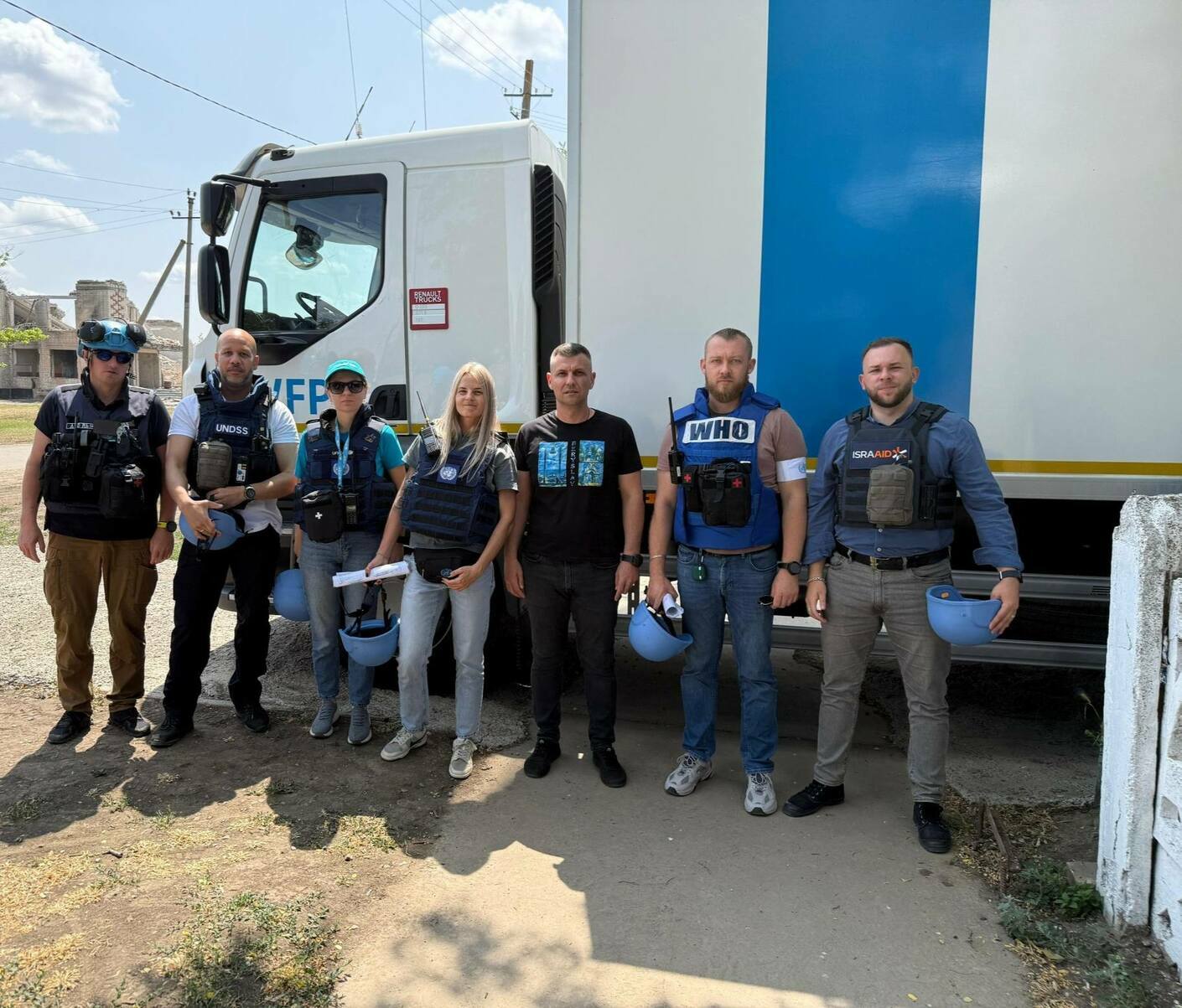
Oleksandr Alchiiev (third from right) during a meeting with the UN humanitarian convoy this summer. The trucks brought charging stations, solar-powered lamps, mattresses, warm blankets, medicines and much more to the Beryslav community. All of this was purchased with the help of the World Food Programme, the World Health Organisation (WHO), the United Nations Population Fund (UNFPA), the New Dawn Charitable Fund, the Tenth of April NGO, UNICEF Ukraine, and IsraAID

Oleksandr Alchiiev, Head of the Beryslav City Military Administration, receives the keys to a mobile water purification station capable of filtering up to 5,000 litres of water per hour, powered by solar panels on the roof. The European Union has sent five such vehicles to the Kherson region as part of the United Nations Development Programme (UNDP)
The Beryslav community received this garbage truck from VNG International as part of the project ‘Supporting the Restoration of Local Self-Government and the Reconstruction and Rehabilitation of Communities in Ukraine’. It is currently in a safe place, waiting for the danger from Russian drones to pass. As part of the project, the community also received a wood chipper and a tractor loader with a snow plough

With funds from a special state subsidy (UAH 3 million) and the Beryslav community’s own funds (UAH 1.5 million), the community purchased a JCB 3CX SITEMASTER backhoe loader ‘to carry out important utility and restoration work in the community’
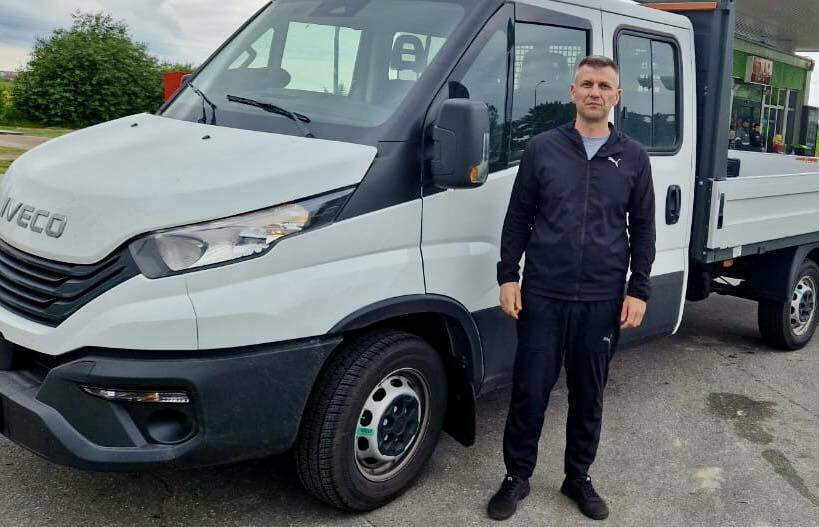
This year, the Beryslav community received a set of special vehicles worth EUR 53,000 from the German municipality of Eutin. This set included, in particular, an IVECO truck with a trailer, a lift and special battery-powered tools

21 November 2025
3 грудня у місті Полтава відбудеться...
3 грудня у місті Полтава відбудеться регіональний форум Програми Polaris «Розбудова системи багаторівневого...
21 November 2025
Експертна оцінка фінансової спроможності громад у розрізі областей за 9 місяців 2025 року
Експертна оцінка фінансової спроможності громад...
Автори: Яніна Казюк, доктор наук з державного управління, професор, експерт з публічних фінансів та місцевого...
21 November 2025
Анонс вебінару: «Перетворення комунального...
Всеукраїнська асоціація органів місцевого самоврядування «Асоціація об’єднаних територіальних громад» у партнерстві...
21 November 2025
Government approves list and requirements for...
The Cabinet of Ministers has approved a list of indicators and requirements to classify Ukrainian communities into...
